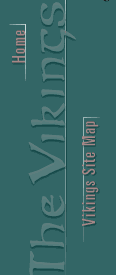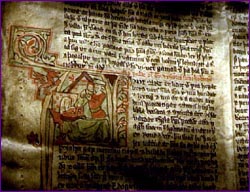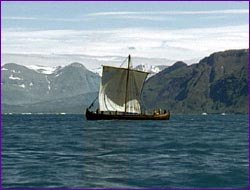
|

|
Part 2 | Back to Part 1 NOVA: Are the Icelandic sagas as unreliable? Fitzhugh: The Icelandic sagas are phenomenal documents that for hundreds of years provided everything we knew about the Vikings. If we were interested in Vinland [the Viking name for a far-off land they visited, which scholars now believe is eastern Canada in and around Newfoundland], it was the sagas, if we were interested in the history of the kings of Norway, it was the sagas. But then, beginning with the discovery of Viking burial ships a century ago, archeology started to poke its nose into Viking affairs, and today, excavations have become an invaluable new source of information. Scholars have gone back to the sagas and asked, "How much of this is history? How much fabrication? How much just the elaboration of family storytelling?" Current saga scholarship is wonderful, because it's giving us a lot of insights as to why the sagas are the way they are. The sagas were compiled in the 13th century and later based on stories that originated as early as 400 or 500 years before that. This is a long time for an oral tradition to be handed down. Even the Vinland sagas, which chronicle events around A.D. 1000, were not recorded for a couple of hundred years after that. Some now believe the sagas are basically family stories relating the ancestry, say, of Erik or of Gudrid and her family. But archeology is actually proving that a lot of these stories have a good basis in fact, so much so that Helge Ingstad could use them to find the L'Anse aux Meadows site [an archeological site in Newfoundland believed to have been a Viking settlement established hundreds of years before Columbus "discovered" America].
Fitzhugh: Well, I think after a few years of using L'Anse aux Meadows as a staging area, the Vikings simply found it untenable in terms of supporting a sizeable group in that new environment. Too far from home, too many dangers. We know from the sagas that they lost people, and they probably lost ships. L'Anse aux Meadows reached a point where it had to move beyond the exploration phase to the settlement phase, and that was not possible. We have to remember that this was in the early days of the Greenland colony, which had only a small number of settlers itself, and to have so much of its resources directed toward a perilous new enterprise was not sensible. So I think the sagas are probably correct when they say, "It's a beautiful, rich land, but we can't defend ourselves in it." NOVA: But this wasn't the end of the Norse in North America, right? Fitzhugh: No. We've seen as a result of archaeological research large amounts of Viking material turning up in Native sites in the Arctic regions of North America. This material dates to perhaps as much as 300 years after the initial Vinland voyages. We seem to have a time period that began with the Vinland contact episode, explorations and so forth, and then after the society in Greenland got rolling and people were settled, walrus-ivory trade with Europe started to be really important. Probably more than any other factor, this stimulated the continuous Western orientation of the Greenland Norse, not only up into the Greenland walrus-hunting territories but across the Davis Strait to Ellesmere and Baffin islands and south into Labrador. These are areas where the Vikings were exploring and trading, and where native populations were trading Viking materials through their own trade networks. Of course, the continuing need for wood in treeless Greenland prompted return visits to Markland, which we know to have been today's Labrador. NOVA: And what happened to the Greenland colonies?
NOVA: What contributed to the end of the Viking age itself? Fitzhugh: The end probably came about as a result of tired Vikings who had become citizens of many places in Europe. They had become Christians back in their homelands, kings had evolved and were instituting taxes, and the economy had become such that you could get along much better as a trader rather than as a raider. The force of Viking onslaughts had caused European kingdoms to become centralized and focused. They had basically gotten their act together, learning how to defend themselves and to gain by trading and negotiating with the Vikings rather than just trying to fight them.
Fitzhugh: I think the Vikings were very adaptive. They learned to take advantage of whatever situation they found themselves in. When they settled in Europe, they took farmlands, yes, but they also met new people; they took slaves, but the slaves became part of their families. Their languages were not that different; they were all Germanic-based languages. (Many of the place-names in the British Isles, in fact, date from Viking times.) And the Vikings were not on a special crusade. They weren't trying to bring paganism to Europe. Quite the opposite, in fact: They were receiving influences from a Europe that they saw as somehow technologically and maybe in some ways politically superior. They weren't out to kill everyone in the countryside but rather to find a way to live, to set up shop, and I think they just readily mixed in. NOVA: In the end, what do you feel was the Vikings' greatest impact on the world? Fitzhugh: I think that without question it was reconnecting humanity, making the world a smaller place by travelling huge distances, connecting peoples from Baghdad to Scandinavia to southern Europe to the north Atlantic to the mainland of North America. From a social or economic or religious point of view, no matter what you think of it, the Viking period was a kind of hinge in European history. It was the time from which you went from early history and classical civilization into what we know as modern Europe and a modern world, in which people are exchanging ideas and moving around rapidly and exploring new frontiers, looking for new resources and new connections. When we look into the future now, I think we implicitly look back to the Vikings as the origin of this kind of human endeavor to find new horizons, go new places, use new technology, meet new people, think new thoughts. In a millennium era as we're in now, this is the inspiration of the Vikings: It's not only the historical impact that they had on Europe and in discovering the North American continent for the first time. These things are interesting and important, but I think that we should look at the Vikings in a broader sense, as a kind of a human myth come true that we can draw on—that is, we can look to space, to the oceans, to explorations among our own peoples, finding new ways of getting along, mixing, and sharing. Images: (3-6) © Sveriges TV; (1,2,7) © SVT, Gala Film, WGBH. Explore a Viking Village | Who Were the Vikings? Secrets of Norse Ships | The Viking Diaspora Write Your Name in Runes | Build a Tree-Ring Timeline Resources | Transcript | Site Map | The Vikings Home Editor's Picks | Previous Sites | Join Us/E-mail | TV/Web Schedule About NOVA | Teachers | Site Map | Shop | Jobs | Search | To print PBS Online | NOVA Online | WGBH © | Updated November 2000 |



